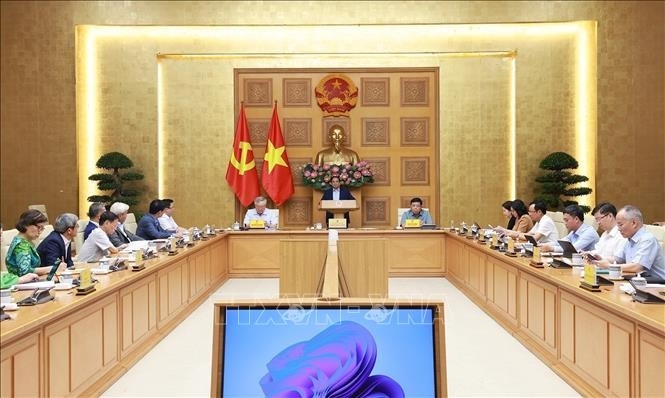Initiated by the Private Economic Development Research Board (Board IV) under the Prime Minister’s Advisory Council for Administrative Procedure Reform, the ViPEL model brings together Vietnam’s largest and most representative private enterprises. Its objective is to harness the collective power of the private sector to make it the key driving force of the national economy. The model promotes a “public–private partnership in national construction” mechanism, under which businesses and state agencies share responsibilities in advancing development strategies.
    |
 |
|
Prime Minister Pham Minh Chinh (center) holds a working session with the Private Economic Development Research Board. |
A key highlight is fostering new actions to ensure the Politburo's Resolution 68-NQ/TW on the private sector's development produces tangible results. Activities will be deployed at three levels – national, provincial, and grassroots – to mobilize businesses of all sizes and across all industries.
At a recent working session with Board IV, Prime Minister Pham Minh Chinh stressed that ViPEL must be implemented in a substantive and effective manner, mobilizing the combined strength of the private sector to help bring Resolution No. 68-NQ/TW to life.
Pham Thi Ngoc Thuy, Director of the Board IV Office, said the model will operate continuously, not for group interests but for the responsibility of designing and implementing comprehensive solutions for the development of the economy and of each industry and field.
Its mission, she said, is to foster the private sector's growth and contribute to building an independent, sustainable, and resilient economy. The model also aims to accompany enterprises in addressing national challenges, strengthening capacity through science, technology, innovation, and digital transformation, while promoting global integration. It will also provide insights into global and domestic contexts, economic trends, and enterprise development, serving as an effective bridge between the private sector and the government.
The program has two main structures. First, permanent committees and working groups that operate year-round to promote substantive contributions from enterprises while reflecting policy bottlenecks to propose solutions. Second, the annual conference, a high-level dialogue that reviews the private sector's overall development, discusses strategic issues, and identifies breakthrough models for the economy.
A notable feature will be the recognition of exemplary models and individuals, as tasked by the Prime Minister. These include “national enterprises,” “entrepreneurs for national construction,” and “innovative localities” that demonstrate dynamism, creativity, and effective public–private partnership.
Thuy added that while businesses already have access to traditional funding channels, the Prime Minister has also assigned Board IV to study and establish a Private Economic Development Fund, as well as connect with new sources to support future public–private projects.
Mai Huu Tin, Deputy Head of Board IV and Chairman of U&I Investment Corporation, described Resolution 68-NQ/TW as a “spark” igniting Vietnamese entrepreneurs’ spirit of dedication. The challenge lies not only in policy but also in how strongly the business community responds to realize the country’s aspirations, he said.
Phan Duc Hieu, a member of the National Assembly’s Committee for Economic and Budgetary Affairs, highlighted the spread of the “public–private partnership for national construction” spirit into the public sector, helping drive positive transformations. “Rather than only providing feedback, businesses should take the initiative to propose concrete policies, especially as the National Assembly prepares to amend 48 business-related laws,” he stressed.
Truong Gia Binh, Head of Board IV, said the board will promote mechanisms for joint action and shared responsibility between the private sector and state agencies. He emphasized that this will be a hub of intelligence, resources, and in-depth perspectives, and bringing forward major solutions from the private business community to develop the private sector into the most important driver of the national economy.
Source: VNA